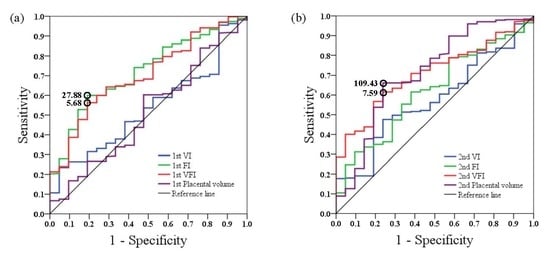Comparison of Placental Three-Dimensional Power Doppler Vascular Indices and Placental Volume in Pregnancies with Small for Gestational Age Neonates
Abstract
:1. Introduction
2. Methods
2.1. Study Population
2.2. Ultrasound Examination
2.3. Statistical Analysis
3. Results
4. Discussion
5. Conclusions
Author Contributions
Funding
Conflicts of Interest
References
- The American College of Obstetricians and Gynecologists Practice Bulletin No. 204: Fetal Growth Restriction. Obstet. Gynecol. 2019, 133, e97–e109.
- Baschat, A.A. Neurodevelopment following fetal growth restriction and its relationship with antepartum parameters of placental dysfunction. Ultrasound Obstet. Gynecol. 2011, 37, 501–514. [Google Scholar] [CrossRef] [PubMed]
- MacLennan, A.H.; Thompson, S.C.; Gecz, J. Cerebral palsy: Causes, pathways, and the role of genetic variants. Am. J. Obstet. Gynecol. 2015, 213, 779–788. [Google Scholar] [CrossRef] [PubMed]
- Rainey, A.; Mayhew, T. Volumes and Numbers of Intervillous Pores and Villous Domains in Placentas Associated with Intrauterine Growth Restriction and/or Pre-eclampsia. Placenta 2010, 31, 602–606. [Google Scholar] [CrossRef] [PubMed]
- Burton, G.J.; Jauniaux, E. Pathophysiology of placental-derived fetal growth restriction. Am. J. Obstet. Gynecol. 2018, 218, S745–S761. [Google Scholar] [CrossRef] [PubMed] [Green Version]
- Audette, M.C.; Kingdom, J.C. Screening for fetal growth restriction and placental insufficiency. Semin. Fetal Neonatal Med. 2018, 23, 119–125. [Google Scholar] [CrossRef] [PubMed]
- Tan, M.Y.; Poon, L.C.; Rolnik, D.L.; Syngelaki, A.; Matallana, C.D.P.; Akolekar, R.; Cicero, S.; Janga, D.; Singh, M.; Molina, F.S.; et al. Prediction and prevention of small-for-gestational-age neonates: Evidence from SPREE and ASPRE. Ultrasound Obstet. Gynecol. 2018, 52, 52–59. [Google Scholar] [CrossRef]
- Crovetto, F.; Triunfo, S.; Crispi, F.; Rodriguez-Sureda, V.; Domínguez, C.; Figueras, F.; Gratacós, E. Differential performance of first-trimester screening in predicting small-for-gestational-age neonate or fetal growth restriction. Ultrasound Obstet. Gynecol. 2017, 49, 349–356. [Google Scholar] [CrossRef]
- Pairleitner, H.; Steiner, H.; Hasenoehrl, G.; Staudach, A. Three-dimensional power Doppler sonography: Imaging and quantifying blood flow and vascularization. Ultrasound Obstet. Gynecol. 1999, 14, 139–143. [Google Scholar] [CrossRef]
- Farina, A. Placental vascular indices (VI, FI and VFI) in intrauterine growth retardation (IUGR). A pooled analysis of the literature. Prenat. Diagn. 2015, 35, 1065–1072. [Google Scholar] [CrossRef]
- González-González, N.L.; González-Dávila, E.; Marrero, L.G.; Padrón, E.; Castro-Conde, J.R.; Plasencia, W.; Conde, J.R.C. Value of placental volume and vascular flow indices as predictors of intrauterine growth retardation. Eur. J. Obstet. Gynecol. Reprod. Biol. 2017, 212, 13–19. [Google Scholar] [CrossRef] [PubMed]
- Hata, T.; Tanaka, H.; Noguchi, J.; Hata, K. Three-dimensional ultrasound evaluation of the placenta. Placenta 2011, 32, 105–115. [Google Scholar] [CrossRef] [PubMed]
- Farina, A. Systematic review on first trimester three-dimensional placental volumetry predicting small for gestational age infants. Prenat. Diagn. 2016, 36, 135–141. [Google Scholar] [CrossRef] [PubMed]
- Papastefanou, I.; Chrelias, C.; Siristatidis, C.; Kappou, D.; Eleftheriades, M.; Kassanos, D. Placental volume at 11 to 14 gestational weeks in pregnancies complicated with fetal growth restriction and preeclampsia. Prenat. Diagn. 2018, 38, 928–935. [Google Scholar] [CrossRef] [PubMed]
- Hoopmann, M.; Schermuly, S.; Abele, H.; Zubke, W.; Kagan, K.O. First trimester pregnancy volumes and subsequent small for gestational age fetuses. Arch. Gynecol. Obstet. 2014, 290, 41–46. [Google Scholar] [CrossRef]
- Hsieh, W.-S.; Wu, H.-C.; Jeng, S.-F.; Liao, H.-F.; Su, Y.-N.; Lin, S.-J.; Hsieh, C.-J.; Chen, P.-C. Nationwide singleton birth weight percentiles by gestational age in Taiwan, 1998–2002. Acta Paediatr. Taiwanica 2006, 47, 25–33. [Google Scholar]
- American College of Obstetricians and Gynecologists; Task Force on Hypertension in Pregnancy. Hypertension in pregnancy. Obstet. Gynecol. 2013, 122, 1122–1131. [Google Scholar] [CrossRef]
- National Diabetes Data Group. Classification and diagnosis of diabetes mellitus and other categories of glucose intolerance. Diabetes 1979, 28, 1039–1057. [Google Scholar] [CrossRef]
- Guiot, C.; Gaglioti, P.; Oberto, M.; Piccoli, E.; Rosato, R.; Todros, T. Is three-dimensional power Doppler ultrasound useful in the assessment of placental perfusion in normal and growth-restricted pregnancies? Ultrasound Obstet. Gynecol. 2008, 31, 171–176. [Google Scholar] [CrossRef]
- Guimarães Filho, H.A.; Mattar, R.; Araujo Júnior, E.; da Costa, L.L.; de Mello Junior, C.F.; Nardozza, L.M.; Nowak, P.M.; Moron, A.F. Reproducibility of three-dimensional power Doppler placental vascular indices in pregnancies between 26 and 35 weeks. Arch. Gynecol. Obstet. 2011, 283, 213–217. [Google Scholar] [CrossRef]
- Collins, S.L.; Birks, J.S.; Stevenson, G.; Papageorghiou, A.T.; Noble, A.; Impey, L. Measurement of spiral artery jets: General principles and differences observed in small-for-gestational-age pregnancies. Ultrasound Obstet. Gynecol. 2012, 40, 171–178. [Google Scholar] [CrossRef] [PubMed]
- Lu, L.; Kingdom, J.; Burton, G.J.; Cindrova-Davies, T. Placental Stem Villus Arterial Remodeling Associated with Reduced Hydrogen Sulfide Synthesis Contributes to Human Fetal Growth Restriction. Am. J. Pathol. 2017, 187, 908–920. [Google Scholar] [CrossRef] [PubMed] [Green Version]
- Pomorski, M.; Zimmer, M.; Florjanski, J.; Michniewicz, J.; Wiatrowski, A.; Fuchs, T.; Milnerowicz-Nabzdyk, E. Comparative analysis of placental vasculature and placental volume in normal and IUGR pregnancies with the use of three-dimensional Power Doppler. Arch. Gynecol. Obstet. 2012, 285, 331–337. [Google Scholar] [CrossRef] [PubMed]
- Moran, M.C.; Mulcahy, C.; Zombori, G.; Ryan, J.; Downey, P.; McAuliffe, F.M. Placental volume, vasculature and calcification in pregnancies complicated by pre-eclampsia and intra-uterine growth restriction. Eur. J. Obstet. Gynecol. Reprod. Biol. 2015, 195, 12–17. [Google Scholar] [CrossRef] [PubMed]
- De Paula, C.F.S.; Ruano, R.; Campos, J.A.D.B.; Zugaib, M. Placental volumes measured by 3-dimensional ultrasonography in normal pregnancies from 12 to 40 weeks’ gestation. J. Ultrasound Med. 2008, 27, 1583–1590. [Google Scholar] [CrossRef] [PubMed]
- Fang, S.W.; Ou, C.Y.; Tsai, C.C.; Fu, H.C.; Cheng, H.H.; Cheng, B.H.; Chang, M.S.; Hsu, T.Y. Second-trimester placental volume and vascular indices in the prediction of small-for-gestational-age neonates. Fetal. Diagn. Ther. 2015, 37, 123–128. [Google Scholar] [CrossRef]
- Quant, H.S.; Sammel, M.D.; Parry, S.; Schwartz, N. Second-Trimester 3-Dimensional Placental Sonography as a Predictor of Small-for-Gestational-Age Birth Weight. J. Ultrasound Med. 2016, 35, 1693–1702. [Google Scholar] [CrossRef]
- Cignini, P.; Maggio Savasta, L.; Gulino, F.A.; Vitale, S.G.; Mangiafico, L.; Mesoraca, A.; Giorlandino, C. Predictive value of pregnancy-associated plasma protein-A (PAPP-A) and free beta-hCG on fetal growth restriction: Results of a prospective study. Arch. Gynecol. Obstet. 2016, 293, 1227–1233. [Google Scholar] [CrossRef]
- Morris, R.K.; Bilagi, A.; Devani, P.; Kilby, M.D. Association of serum PAPP-A levels in first trimester with small for gestational age and adverse pregnancy outcomes: Systematic review and meta-analysis. Prenat. Diagn. 2017, 37, 253–265. [Google Scholar] [CrossRef]
- Velauthar, L.; Plana, M.N.; Kalidindi, M.; Zamora, J.; Thilaganathan, B.; Illanes, S.E.; Khan, K.S.; Aquilina, J.; Thangaratinam, S. First-trimester uterine artery Doppler and adverse pregnancy outcome: A meta-analysis involving 55 974 women. Ultrasound Obstet. Gynecol. 2014, 43, 500–507. [Google Scholar] [CrossRef]
- Pedroso, M.A.; Palmer, K.R.; Hodges, R.J.; Costa, F.D.S.; Rolnik, D.L. Uterine Artery Doppler in Screening for Preeclampsia and Fetal Growth Restriction. Rev. Bras. Ginecol. Obs. 2018, 40, 287–293. [Google Scholar] [CrossRef] [PubMed] [Green Version]
- Jones, N.W.; Raine-Fenning, N.J.; Bradley, E.; Bugg, G. Placental 3-D Power Doppler Angiography—Regional Variation and Reliability of Two Ultrasonic Sphere Biopsy Techniques. Ultrasound Med. Biol. 2011, 37, 364–375. [Google Scholar] [CrossRef] [PubMed]
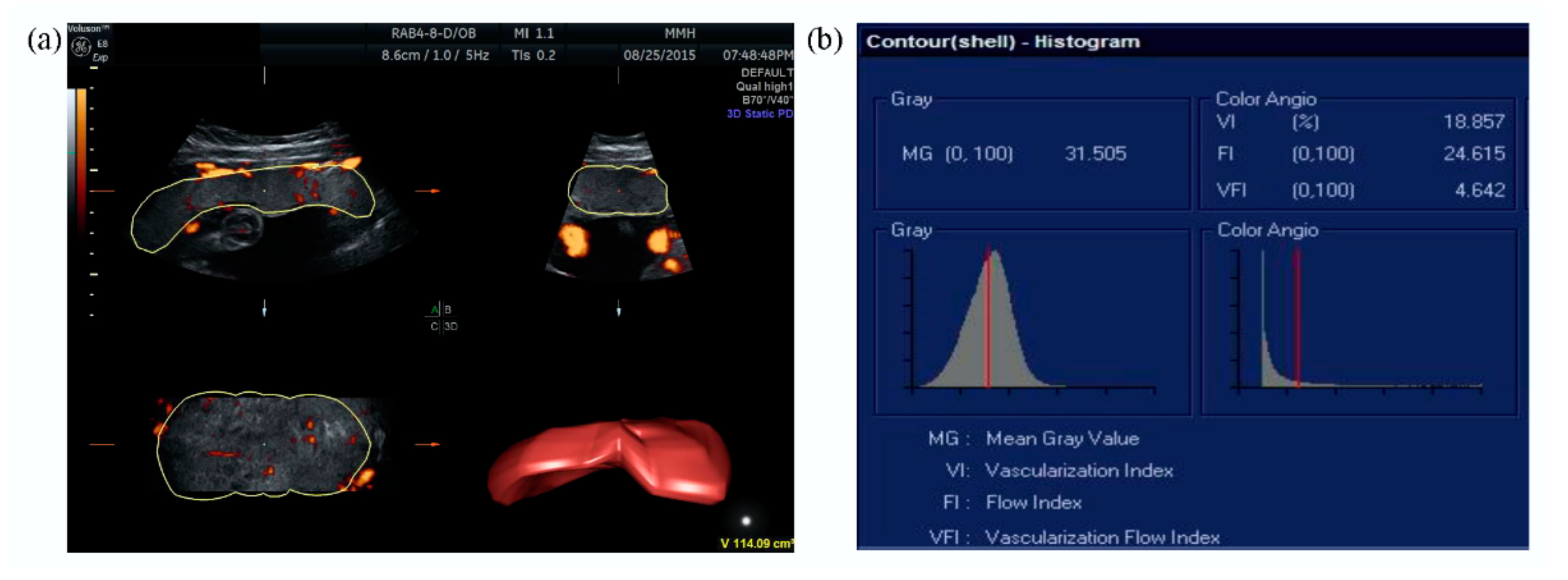
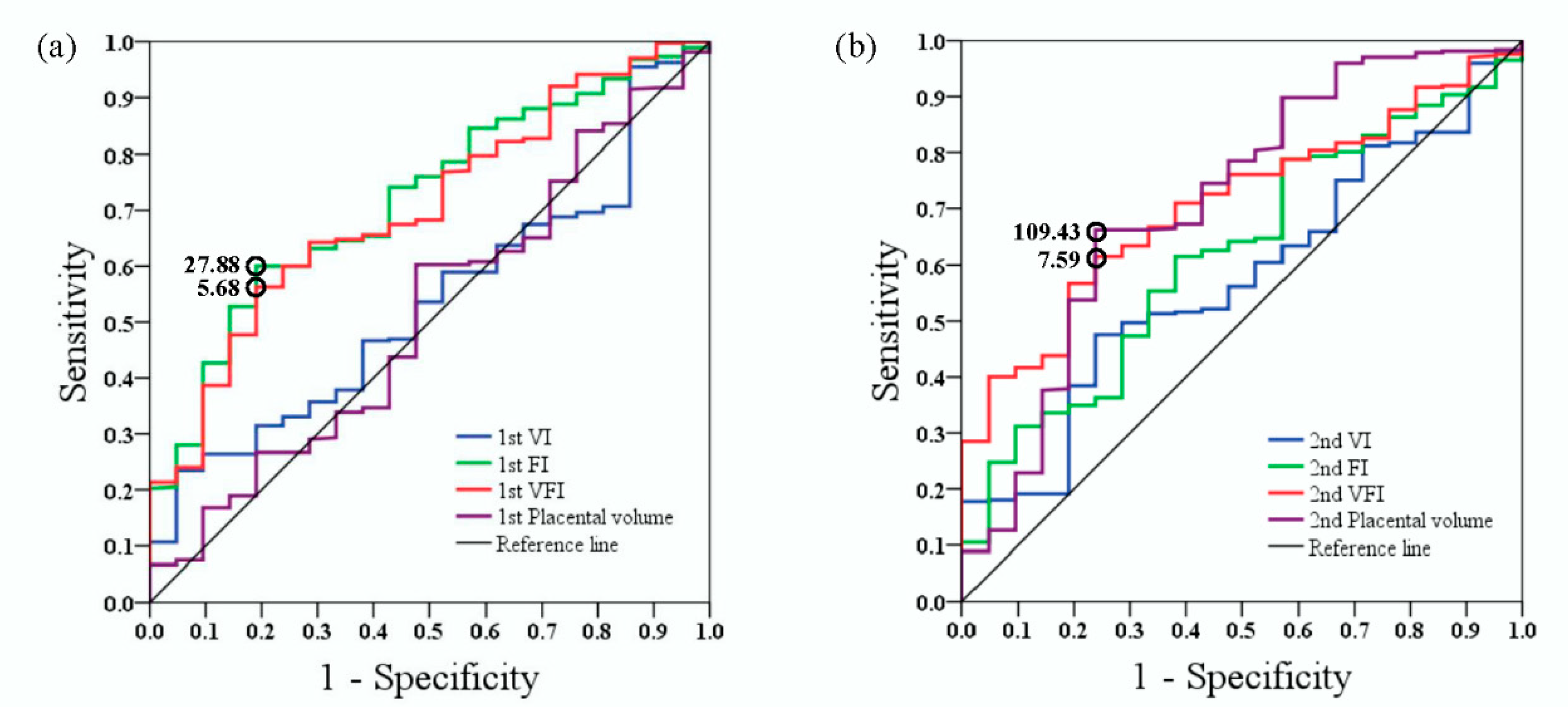
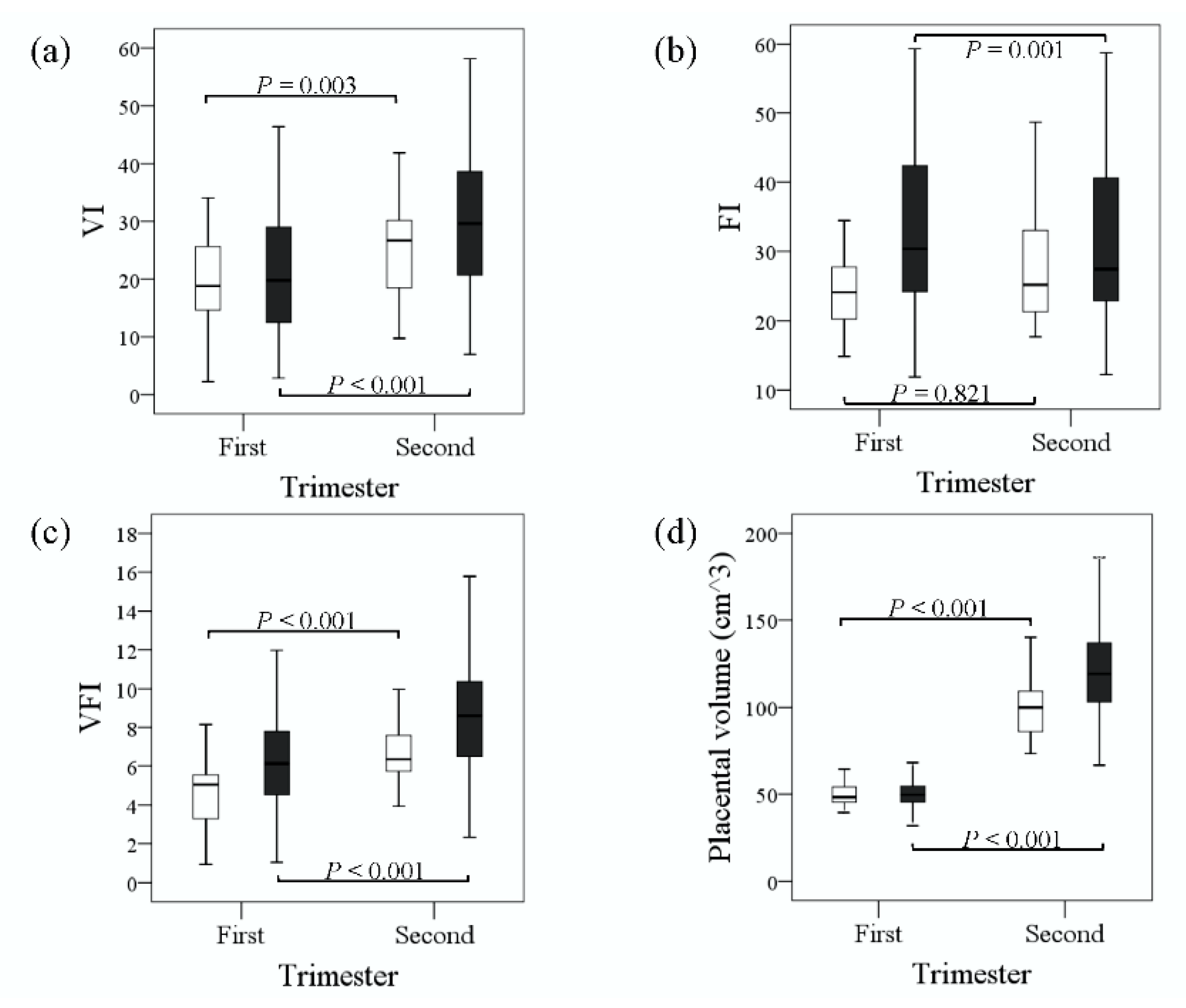
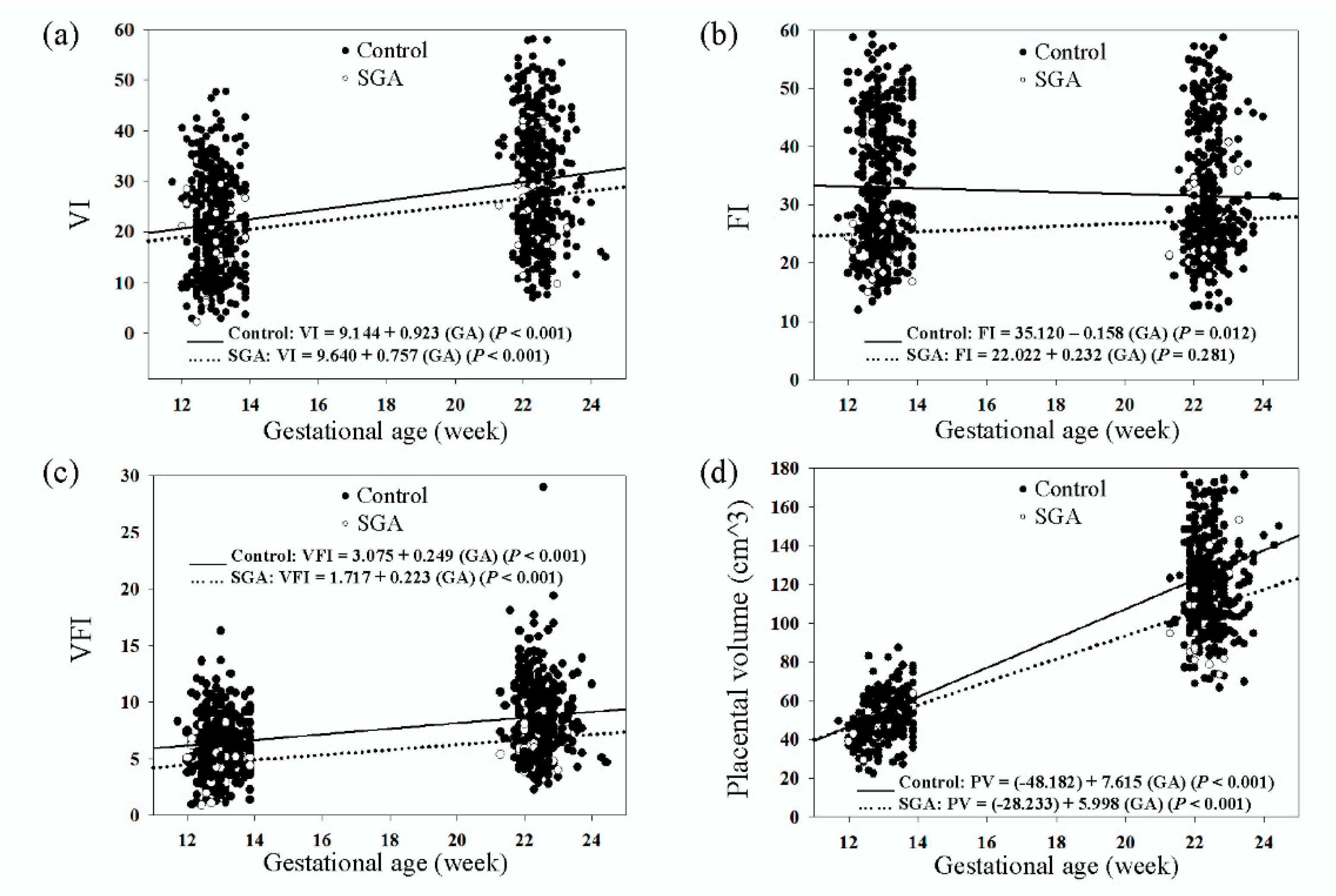
| SGA (n = 21) | Non-SGA (n = 375) | p | |
|---|---|---|---|
| Mother | |||
| Age (years) | 31.67 ± 3.75 | 31.96 ± 3.66 | 0.724 |
| BMI (kg/m2) | 21.65 ± 3.72 | 21.80 ± 3.62 | 0.849 |
| Gravida | 2.19 ± 1.33 | 2.02 ± 1.09 | 0.502 |
| Para | 0.62 ± 0.59 | 0.57 ± 0.65 | 0.740 |
| Cesarean delivery | 11 (52.40) | 93 (24.80) | 0.005 * |
| Chronic hypertension | 4 (19.05) | 9 (2.40) | 0.003 * |
| Gestational hypertension | 0 | 3 (0.80) | >0.999 |
| Preeclampsia | 5 (23.81) | 2 (0.53) | <0.001 * |
| Type I DM | 0 | 2 (0.53) | >0.999 |
| Type II DM | 0 | 5 (1.33) | >0.999 |
| GDM | 1 (4.76) | 30 (8.00) | >0.999 |
| Neonate | |||
| Delivery age (weeks) | 36.67 ± 2.37 | 38.69 ± 1.56 | 0.001 * |
| Birth weight (g) | 2175.00 ± 426.91 | 3139.18 ± 406.73 | <0.001 * |
| Apgar score | |||
| 1 minute | 8.57 ± 1.33 | 9.21 ± 0.97 | 0.005 * |
| 5 minutes | 9.48 ± 0.87 | 9.69 ± 0.63 | 0.277 |
| SGA (n = 21) | Non-SGA (n = 375) | p | |
|---|---|---|---|
| First trimester | |||
| GA at examination (weeks) | 12.90 ± 0.51 | 12.95 ± 0.44 | 0.600 |
| PAPP-A (IU/L) | 3.63 (5.14) | 5.39 (4.73) | 0.226 |
| Free β-hCG (IU/L) | 43.36 (28.37) | 45.50 (38.90) | 0.260 |
| CRL (mm) | 66.39 ± 6.88 | 67.66 ± 5.99 | 0.348 |
| VI | 19.32 ± 8.25 | 20.99 ± 9.63 | 0.436 |
| FI | 25.10 ± 7.51 | 33.10 ± 10.97 | <0.001 * |
| VFI | 4.59 ± 1.95 | 6.28 ± 2.35 | 0.001 * |
| Placental volume (cm3) | 49.46 ± 8.22 | 50.34 ± 9.30 | 0.672 |
| Uterine artery PI | 1.69 ± 0.57 | 1.68 ± 0.44 | 0.939 |
| Second trimester | |||
| GA at examination (weeks) | 22.24 ± 0.45 | 22.42 ± 0.49 | 0.089 |
| BPD (cm) | 5.31 ± 0.31 | 5.49 ± 0.23 | 0.001 * |
| AC (cm) | 17.04 ± 0.94 | 17.68 ± 0.97 | 0.004 * |
| FL (cm) | 3.70 ± 0.20 | 3.81 ± 0.19 | 0.007 * |
| VI | 26.57 ± 9.54 | 29.94 ± 11.68 | 0.195 |
| FI | 27.08 ± 7.97 | 31.54 ± 11.01 | 0.022 * |
| VFI | 6.68 ± 1.71 | 8.68 ± 3.09 | <0.001 * |
| Placental volume (cm3) | 104.80 ± 24.23 | 122.67 ± 26.35 | 0.003 * |
| Uterine artery PI | 1.02 ± 0.42 | 0.93 ± 0.22 | 0.330 |
| ICC | 95% CI | p | |
|---|---|---|---|
| VI | 0.983 | 0.958–0.993 | <0.001 * |
| FI | 0.929 | 0.821–0.972 | <0.001 * |
| VFI | 0.954 | 0.885–0.982 | <0.001 * |
| Placental volume | 0.961 | 0.903–0.985 | <0.001 * |
| Variables | Univariate Logistic Regression | Multivariate Logistic Regression | ||||
|---|---|---|---|---|---|---|
| Unadjusted OR | 95% CI | p | Adjusted OR | 95% CI | p | |
| First trimester | ||||||
| VFI | 0.70 | 0.56–0.88 | 0.002 * | 0.76 | 0.60–0.96 | 0.024 * |
| Placental volume | 0.99 | 0.94–1.04 | 0.671 | 0.99 | 0.94–1.05 | 0.872 |
| Second trimester | ||||||
| VFI | 0.74 | 0.61–0.90 | 0.003 * | 0.78 | 0.63–0.96 | 0.021 * |
| Placental volume | 0.97 | 0.94–0.99 | 0.003 * | 0.97 | 0.95–0.99 | 0.007 * |
| First trimester (per 1 SD) | ||||||
| VFI | 0.43 | 0.25–0.73 | 0.002 * | 0.43 | 0.25–0.73 | 0.002 * |
| Placental volume | 0.91 | 0.59–1.41 | 0.671 | 0.99 | 0.65–1.52 | 0.969 |
| Second trimester (per 1 SD) | ||||||
| VFI | 0.41 | 0.23–0.74 | 0.003 * | 0.39 | 0.21–0.74 | 0.004 * |
| Placental volume | 0.39 | 0.22–0.73 | 0.003 * | 0.43 | 0.25–0.77 | 0.004 * |
© 2019 by the authors. Licensee MDPI, Basel, Switzerland. This article is an open access article distributed under the terms and conditions of the Creative Commons Attribution (CC BY) license (http://creativecommons.org/licenses/by/4.0/).
Share and Cite
Chen, S.-J.; Chen, C.-P.; Sun, F.-J.; Chen, C.-Y. Comparison of Placental Three-Dimensional Power Doppler Vascular Indices and Placental Volume in Pregnancies with Small for Gestational Age Neonates. J. Clin. Med. 2019, 8, 1651. https://doi.org/10.3390/jcm8101651
Chen S-J, Chen C-P, Sun F-J, Chen C-Y. Comparison of Placental Three-Dimensional Power Doppler Vascular Indices and Placental Volume in Pregnancies with Small for Gestational Age Neonates. Journal of Clinical Medicine. 2019; 8(10):1651. https://doi.org/10.3390/jcm8101651
Chicago/Turabian StyleChen, Sue-Jar, Chie-Pein Chen, Fang-Ju Sun, and Chen-Yu Chen. 2019. "Comparison of Placental Three-Dimensional Power Doppler Vascular Indices and Placental Volume in Pregnancies with Small for Gestational Age Neonates" Journal of Clinical Medicine 8, no. 10: 1651. https://doi.org/10.3390/jcm8101651
APA StyleChen, S.-J., Chen, C.-P., Sun, F.-J., & Chen, C.-Y. (2019). Comparison of Placental Three-Dimensional Power Doppler Vascular Indices and Placental Volume in Pregnancies with Small for Gestational Age Neonates. Journal of Clinical Medicine, 8(10), 1651. https://doi.org/10.3390/jcm8101651




